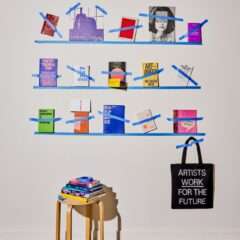–>Sam walks us through a show of globally-relevant issues at Pentimenti in the gallery’s annual open call show. Most of the artists haven’t shown in the gallery before.–the artblog editors—————>
The problems of garbage and pollution are just some of the issues confronted by Philadelphia artists in Global Conscious, Local Artists, at Pentimenti Gallery in Old City.
Trash talk
Most people, myself included, operate some of the time on the belief that our garbage just disappears after it’s taken away by waste management trucks. But in fact, the total tonnage of human waste will grows infinitely until we figure out what to do about it. If we don’t we are looking at more “Garbage Islands” (see Pacific garbage patch), the well-established phenomenon in which cross-currents in the Pacific Ocean have spontaneously conglomerated mass quantities of floating debris into a grouping of waste that has literally formed its own island.
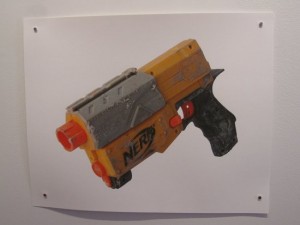
Tim Eads is one of a group of artists that produced, The Taxonomy of Trash: An Analytical Approach to Garbage, described as “a visual, intellectual and aural celebration of garbage.” 2137 (above), a picture of a dirty old Nerf gun plucked from a Philadelphia garbage dump, and seven other photos of pieces of trash are up in this show, all drawn from this multidisciplinary project to find beauty in a trash heap. The Taxonomy of Trash was created when a group of artists, known as Recycled Artist-in-Residency, entered the facilities of Philadelphia’s Revolution Recycling LLC in October 2011 and dove for treasure. Along with Eads, photographer Carlos Avendanos, videographer Raul Romero (whose work is also up in this show), sound engineer Austen Brown, and biologist Stacey Dougherty all played a part – first by finding, photographing, and filming the objects, recording the sounds they made when dropped, and in the biologist’s phase, analyzing the compounds in each object and diagramming them according to the phylogenetic tree of life. Bereft of context, these items can resemble objects from alien or ancient civilizations, but in an over-priced piece of plastic, like the toy shown in 2137 which is sold to children who relish games of violence, I can see the whole narrative of a wasteful consumerist culture which is riddled with decadence, sloth and waste.
The relevance of religion in the digital age
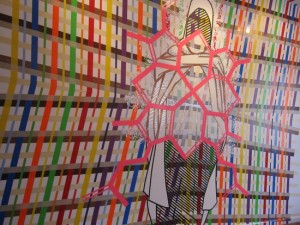
Taking an alternate approach to the concerns of the global world, Jay Walker’s installation Theotokos: Ichor, at first blush just a wall of tangled stripes and colors, raises questions about the relevance of traditional Christian imagery in the digital, high-tech world. The multi-colored and dynamic piece is like a vision of what the air surrounding us would resemble if the ubiquitous wireless signals from radio, cell phones, internet were made visible. The title of the piece also gives some insight into the artist’s intentions. Theotokos is an archaic Greek name for the Virgin Mary that literally translates to “God-bearer.” Ichor, another Greek word, means the blood of a god. Suddenly Walker’s piece is a potential representation of a scene from a Biblical passion play, adapted to modern times. The red geometric pattern emerging from the central figure, whether representing an electric signal or digital information, seems akin to a divine vein of some kind of invigorating life force.
Sick infrastructure, sick bodies

An intimidating organic piece in Pentimenti’s project room brings up associations of the inexplicable dread of organic proliferation, the simple process of cells dividing and replicating, which to the modern mind carries suggestions of cancer and the human immunodeficiency virus syndrome. Emily Schnellbacher took over the project room with Fall, an overflowing representation of blue balls resembling an organic growth of malignant-looking cells. Spilling out from PVC pipes in the corner of a grimly industrial room which resembles a basement, the installation is stark and frightening, while at the same time like a friendly reminder of childhood – resembling blue bean bags that kids could toss at each other or dive into. Many of Schnellbacher’s other installations, viewable on her website, tread the fine line between aesthetically pleasing organic forms and the grotesque, overwhelming impression of exposed viscera and intestinal forms.
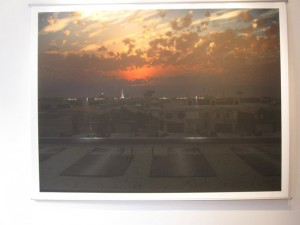
Other artworks rounding out the show include Tim Portlock’s beauteous, video game-animated reimaginings of Philadelphia and Las Vegas after an apocalypse; Raul Romero’s videos of regressed hipsters playing children’s games amidst crumbling urban blight; and Shaina Craft’s layered dream-like pastel portraits.
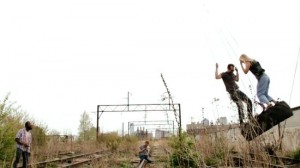
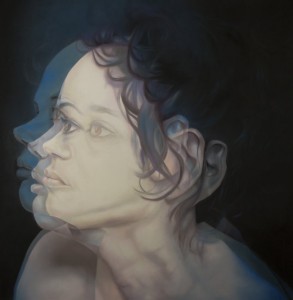
The social, cultural, intellectual and economic issues that these works evoke are, to some degree, universal and ever-present in our collective consciousness. How each artist represents these themes, whether through imaginative imagery, like Walker’s Theokotos: Ichor, or depictions that are hyper-real, like Eads’ The Taxonomy of Trash, opens viewers up to a plethora of relational inquiries into these dark depictions of the world.
Global Conscious, Local Artists will be up at Pentimenti Gallery through July 13.



